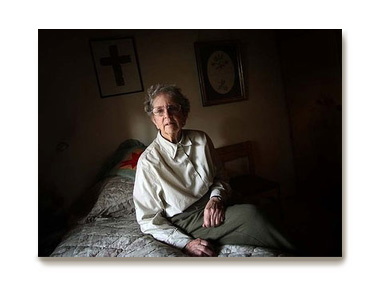Ernabella Craft Pioneer Dies

Aboriginal Art Directory | 11.03.12
Author: Hilary Furlong
News source: Sydney Morning Herald
In her 1968 book, The People in Between, about her life at Ernabella Mission station, Winifred Hilliard wrote, ''To the north there are bad people, and to the south there are bad people, but in between are the Pitjantjatjara people''. The book was written ''to fill in some of the gaps in our knowledge of the original occupants of our land'' and, throughout her life, Hilliard was an advocate for these people.
In her 32 years at Ernabella as ''craft room adviser'', as she once described herself to a newspaper reporter, Hilliard worked with cultural sensitivity and great perception, insight, rigorous personal discipline, a deeply considered methodology of management and an application of herself to her work of helping artists - several times to physical collapse.
Winifred Margaret Hilliard was born on September 29, 1921 in Melbourne, daughter of Errol Hilliard and his wife, Helen (nee Alexander). Her inspirational aunts included Katherine, one of the first women Masters of Art from the University of Melbourne; Jean, who taught chemistry to medical students; and Margaret, who spent her life as a missionary in Korea.
After local schooling, Hilliard did her missionary training at Presbyterian Ladies' College and in 1950 was ordained as a deaconess in the Presbyterian church. In 1954 she arrived at Ernabella Mission, 350 kilometres from the railway station at Finke, South Australia, to take over the craft industry there.
Ernabella ran nearly 5000 sheep, which gave stock training to the men and produced the wool used in the ''craft room'', set up in 1948 to teach useful skills to the women and girls and to bring in income.
The original craft staff knew hand-loom weaving and the Pitjantjatjara and Yankunytjatjara people already practiced a millennia-old spinning skill using human hair and animal fur to make a thread. Before Hilliard's arrival, the women had already adapted their spinning to sheep's wool and taken up weaving.
When Hilliard started, there was little wider interest in Aboriginal art or craft work and no market for it. With her encouragement and technical training, the weaving was soon popular, from lacy shawls to sturdy tartan knee rugs and Gobelin weave tapestries. The other wool work she developed with the women was hand-knotted floor rugs incorporating their original designs (walka). Those that survive are now in museum collections, or treasured by owners.
Along with the wool work, which was replaced in the early 1970s by batik, Hilliard also introduced the women to metal work, ceramics, leather moccasin-making using kangaroo skins (which came from Adelaide - the local kangaroos were totemic), painting and punu - the roots of river red gums carved then decorated with pokerwork.
The tyranny of distance did not prevent Hilliard from beginning Ernabella's still-followed vigorous exhibitions policy. In 1964, work was shown at the Royal Melbourne Show (categorised as craft and less prestigious than art) and in Alice Springs.
In 1974, after the Board of Missions had withdrawn from Ernabella and before the Pitjantjatjara Yankunytjatjara Lands Rights Act 1981 (SA), Hilliard set up Ernabella and Fregon Arts Inc, ensuring the independence of the artists and their business.
As part of this, in 1975, Hilliard arranged for three Ernabella artists to study at the royal batik institute in Yogyakarta. As well, beginning in 1983, Hilliard arranged trips to Japan, where a relationship had been established with the National Museum of Ethnology in Osaka.
After her retirement to Shoalhaven Heads in 1986, Hilliard remained in touch with the Ernabella people. In the past decade she travelled to Darwin, Canberra, Adelaide and Sydney as well as, in 2008, to Ernabella for the art centre's 60th anniversary celebrations. She also finalised the gift of her collection of Ernabella items to the National Museum of Australia.
Hilliard was also an accomplished photographer and her collection of negatives were given to the Australian Institute of Aboriginal and Torres Strait Islander Studies.
Winifred Hilliard is survived by her brothers Alec and David, niece Susan, her nephews Peter, Geoffrey, Craig, Andrew and Grant and a large extended family.
Her burial service will be held in the Ernabella Uniting Church on Saturday, March 17. Memorial services will be held in the Uniting Church, Port Adelaide, SA, at 11am Monday, March 19, the Berry Gateway Uniting Church, at 11am Sunday, March 25 and in Melbourne on a date to be fixed.
Read more: http://www.smh.com.au/national/obituaries/a-humanitarian-in-the-truest-sense-20120309-1upn6.html#ixzz1olsYnIRa
URL: http://www.smh.com.au/national/obituaries/a-humanitarian-in-the-truest-sense-20120309-1upn6.html
Share this:
»  del.icio.us
»
del.icio.us
»  Digg it
»
Digg it
»  reddit
»
reddit
»  Google
»
Google
»  StumbleUpon
»
StumbleUpon
»  Technorati
»
Technorati
»  Facebook
Facebook
Contact Details
Further Research
Artists: Ernabella
News Tags: Ernabella Mission station | Pitjantjatjara | Winifred Hilliard
News Categories: Blog
News Archive
- 11.10.17 | RETURN OF MUNGO MAN
- 10.10.17 | TARNANTHI 2017
- 11.08.17 | Natsiaas 2017
- 08.08.17 | ABORIGINAL ART ECONOMICS
- 02.08.17 | SCHOLL'S NEXT MOVE
- 20.07.17 | APY ART DOMINATES THE WYNNE
- 17.07.17 | Anangu Artist Wins $100,000 Prize
- 14.07.17 | The End of AAMU
- 13.07.17 | YOU ARE HERE
- 11.07.17 | ART ACROSS THE COUNTRY
- 11.07.17 | TARNANTHI IN OCTOBER
- 05.07.17 | TJUNGUṈUTJA - from having come together
- 02.07.17 | BENNELONG
- 27.06.17 | JIMMY CHI
- 23.06.17 | Blak Markets at Barangaroo
Advertising

